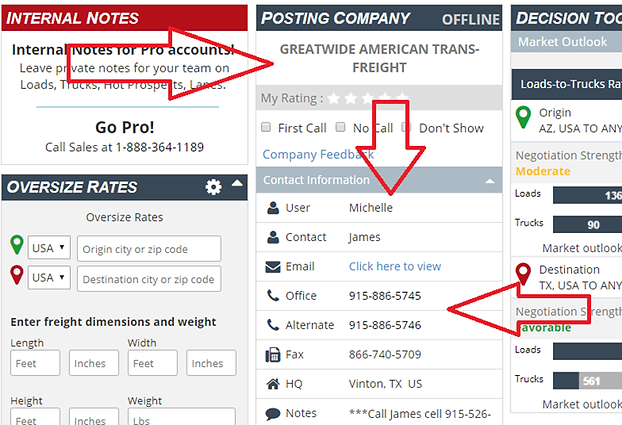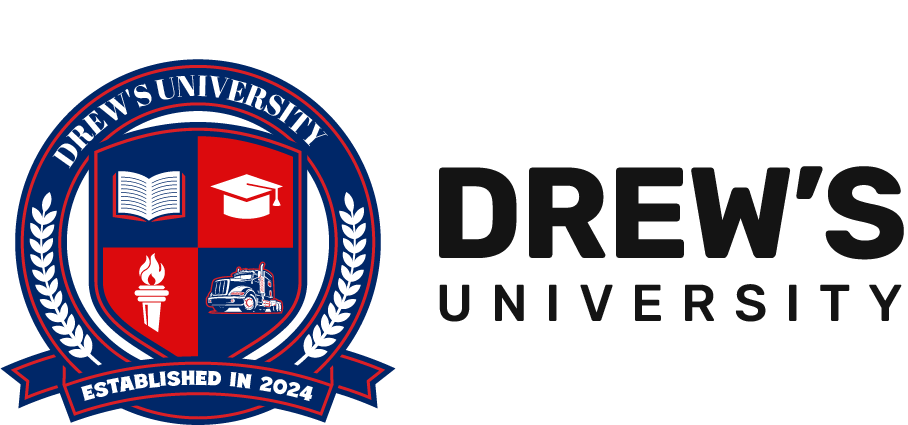MODULE 3: BOOKING THE LOAD DIALOGUE WITH BROKERS OR SHIPPERS:
After completing Module 2, you must now be familiar with:
· The concept of Load Boards.
· Finding loads for carriers based on their particular carrier profile.
After successfully locating a load that matches your carrier's profile (an essential aspect), the next step is to reach out directly to the company that posted the load, whether it's a Broker or a Shipper.

XYZ Logistics: “Hello, Chris (the Broker, as per the screenshot and listed phone number), this is Ben from XYZ Logistics inquiring about the flatbed load from Ft. Huachuca, AZ to Ft. Bliss, TX scheduled for today. Is the load still available? I would appreciate some details before confirming the booking.”
It's important to ask about the load's availability because loads can be booked and removed from load boards without notice.
Usually, the Broker or Shipper will ask for your MC number to check if your carrier is set up with them or not, or they may start providing details about the load to initiate the booking process. The Broker may ask, What is your MC number? If you have a dispatcher agreement with them, provide the MC number. The Broker will then check if the load is still available and confirm accordingly.
At this point, before confirming the booking, ask for comprehensive load details to inform your carrier's decision-making process. Utilize the LOAD DETAILS cheat sheet in the Back Office of DISPATCHER 101 under FORMS and DOCUMENTS, and refer to your carrier’s PROFILE SHEET to ensure the load meets your carrier’s requirements.
They are also verifying your carrier's MC number in their system to confirm whether your carrier is established and approved within their Brokerage.
BROKER: (For this example's sake, let's assume the load is still available) "Yes, the load is still available. Would you like to proceed with booking it?"
Before finalizing the booking with the Broker, this is the stage where you request additional load details to inform your carrier's decision-making process accurately.
You can refer to the LOAD DETAILS cheat sheet, accessible in the Back Office of DISPATCHER 101 under “FORMS and DOCUMENTS,” and consult your carrier’s PROFILE SHEET to gather comprehensive details about the load. This step ensures that the load aligns with your carrier’s specific requirements.
XYZ Transport: "Could you provide more information about the load so that we can assess whether we want to proceed with booking it?"
BROKER: "The load originates from Ft. Huachuca, AZ at 0930 on Saturday, located on the base. Your carrier must possess a TWIC (Transportation Worker Identification Card) and a clear background check. It will be delivered on Monday at 0800, also on base, at Ft. Bliss, TX. The load weighs 20,000 pounds and requires a 48 ft. flatbed. It spans 316 loaded miles and offers a payment of $1,000 to the truck."
Referencing your load details cheat sheet and carrier’s profile is crucial at this point to ensure all necessary information is covered for your carrier. Specifically, check for details such as the commodity, tarps required, or any special instructions.
XYZ Transport: "Are tarps needed for the load? If yes, what size is required? Are there any specific instructions or special requirements for the load? What type of commodity is being transported?"
BROKER: "The load requires 6 ft. drops and consists of Military Equipment. There are no additional special instructions apart from the TWIC and background check prerequisites. Would you like to proceed with booking the load?"

At this point, consult with your carrier to confirm if they want to proceed with booking the load based on the provided load details and their profile. Let's assume your carrier wants this load booked.
XYZ Transport: "Yes, we would like to book this load."
BROKER: "Great. After reviewing your carrier's MC number, it appears that you are not yet set up or approved as a carrier with us. Not to worry. Could you please provide me with the email address to send the carrier packet for completion and return? Also, remember to list us as a certificate holder on the insurance when you send it back. Thank you."
As the dispatcher for your carrier, you would provide your email address at this stage to stay involved in the booking process and remain informed about the progress.
XYZ Transport: "The email is [email protected]. The contact name is John Smith, and the phone number is 555-987-6543."
The Broker will typically email the carrier packet in either a PDF format attached to the email or provide a link to a website to complete the packet online.
BROKER: "When completing the packet, please include a copy of the carrier’s W9, MC authority, and certificate of insurance, with us listed as a certificate holder. Additionally, what is the driver’s full name, cell number, truck number, and trailer number?"
These initial inquiries help the Broker inform their customer and build the load in their TMS system for generating a Rate Confirmation later.
XYZ Transport: "The driver for this load will be Mark Johnson, with cell number 555-678-4321; truck number 789; trailer number 012."
BROKER: "Thank you. The packet is being sent your way."
XYZ Transport: "Much appreciated. We will complete it promptly and return it to you."
If your carrier has granted consent (Limited Power of Attorney) or if your dispatcher agreement allows you to fill out carrier packets and rate confirmations on behalf of your carrier (with their signed authorization), it can expedite the process.
CARRIER PACKETS
Once a carrier is approved by the Broker, only one carrier packet needs to be completed, unless there are updates required for outdated documents such as the MC authority or certificate of insurance. It's crucial to be mindful of your carrier’s document expiration dates to ensure timely renewals without any overlap or delays.
Carrier packets, which are essentially Broker/Carrier agreements, outline the requirements for becoming an approved carrier under the brokerage. These requirements typically include:
Certificate of Insurance with minimum coverage of $100,000 for Cargo and $1,000,000 for Liability.
Broker Payment options such as Quick-Pay at 5%, ACH at 3%, or Standard 15 to 30-day check for FREE, as well as Factoring options.
Detention pay requirements, Lumper fees (if applicable), and any other specific requirements.
Additionally, the carrier packets provide details about the Broker’s credentials, allowing carriers to verify their legitimacy. It's crucial to carefully review and understand all the terms and requirements outlined in the carrier packet before signing.
BROKER/CARRIER AGREEMENT
CARRIER SUPPORTING DOCUMENTS
C.O.I.
W9
Credit App
N.O.A.
Other essential documents required to effectively book loads with brokers include:
Carrier’s MC AUTHORITY certificate letter issued by FMCSA (Federal Motor Carrier’s Safety Administration) in coordination with DOT (Department of Transportation), showcasing the carrier's unique DOT# and MC# under common carrier authority, though other types like Contract, Passenger, and Household Goods (HHG) authority may also apply.
Carrier’s Certificate of Insurance (COI) demonstrating minimums of $100,000 cargo insurance and $1,000,000 liability insurance coverage.
Carrier’s W9 containing their Federal ID# or EIN (Employee Identification Number) and business name.
Carrier’s Credit Application & Notice of Assignment (NOA), a form provided by a carrier's "factoring company" to the broker, allowing credit checks to assess payment reliability and notifying the Broker about the carrier's association with a factoring company.
RATE CONFIRMATIONS (RATE CONS)
Rate confirmations (Rate Cons) are the documents that, once signed and returned to the Broker, finalize the booking and mark the load as BOOKED/COVERED/GONE! It's crucial to ensure that the information in the Rate Confirmation matches the details initially posted for the load on the load board, unless there have been changes agreed upon between the dispatcher and the Broker regarding the rate, etc.
The load is considered officially booked only after the rate confirmation is signed and returned to the Broker.
In case the Broker cancels the load after the Rate Con is signed, a T.O.N.U. (Truck Ordered, Not Used) can be invoiced to the Broker. This covers the expenses incurred by the carrier, including fuel costs and wasted time, from driving to the shipper location.
An alternative term for Shipper (pick-up location) is Consignor, while Receiver (delivery location) is also known as Consignee.
